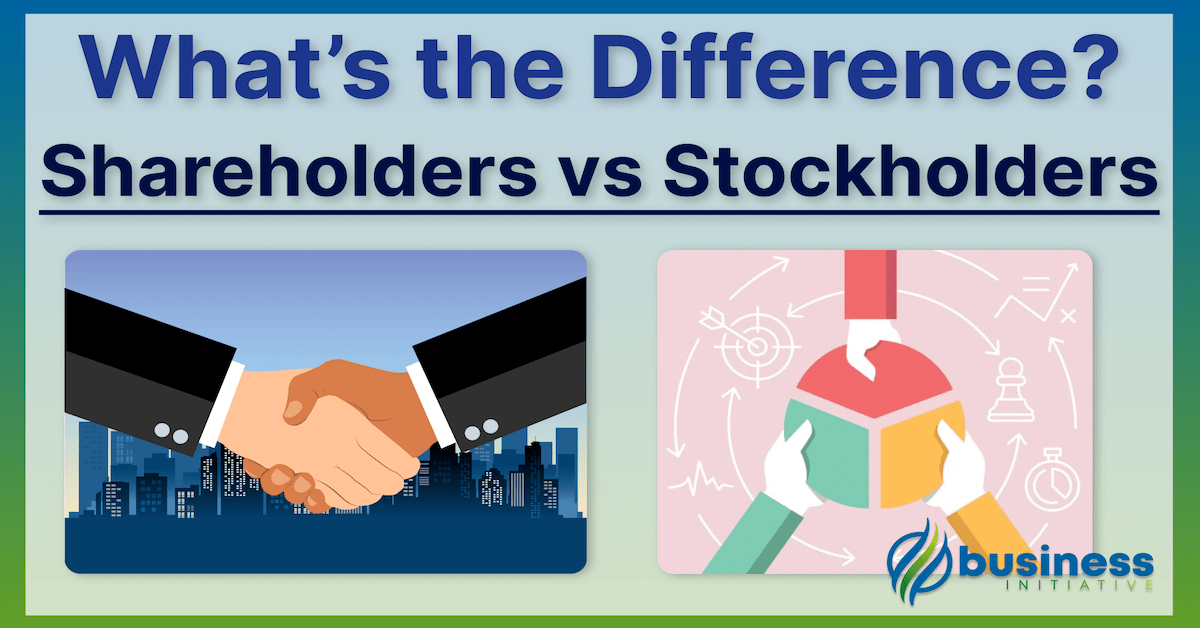Welcome to our comprehensive guide on understanding the crucial differences between shareholders and stockholders, and their impact on the world of business.
In this article, we delve into the nuances of corporate governance, financial benefits, and the risks associated with shareholding.
 Key Takeaways
Key Takeaways
- Shareholders vs. Stockholders: Shareholders own shares in any company, while stockholders specifically own stock in a corporation, both with varying rights and responsibilities.
- Types of Shares: Common shares offer voting rights and potential dividends, while preferred shares provide priority in dividend payments and asset claims but usually have no voting rights.
- Investment Strategies: Diversify your portfolio for risk management, consider long-term holding for growth, and stay informed to make strategic decisions.
- Shareholder Activism: Use your shareholder status to influence company decisions and advocate for changes that can enhance shareholder value and drive positive corporate changes.
- Legal and Financial Implications: Understand your legal rights as a shareholder, including voting, dividends, and information access, and manage your financial interests and tax obligations accordingly.
By grasping these concepts, you’ll be better equipped to make informed decisions, whether you’re an entrepreneur, an investor, or simply looking to broaden your business knowledge.
To get the most out of this article, we recommend reading each section carefully and reflecting on how the information applies to your current situation or future endeavors.
Take notes on key points that resonate with you, and consider how you can implement these insights into your business strategy.
Ready to embark on this enlightening journey?
 Table of Contents
Table of Contents
Keep reading to unlock valuable knowledge that will empower you to navigate the complex landscape of corporate ownership and investment with confidence.
Are Shareholders and Stockholders the Same?
At first glance, they might seem like synonyms, and in many contexts, they are used interchangeably.
However, some nuances can make a difference in certain situations.
In the corporate world, shareholders and stockholders both refer to individuals or entities that own shares in a company.
These shares represent a slice of ownership and come with certain rights, such as voting on corporate matters and receiving dividends.
But here’s where it gets interesting…
While all stockholders are shareholders, not all shareholders are stockholders.
Confused?
Don’t worry; we’ll delve deeper into this distinction and why it matters as we go along.
Understanding the difference between shareholders and stockholders is more than just a matter of semantics.
It’s about grasping the roles and rights associated with owning a piece of a company.
Let’s start with the cornerstone concepts of shareholders and stockholders.
Defining the Terms - Shareholder vs. Stockholder
In the world of business and finance, understanding the roles and rights of those who invest in companies is crucial.
Let’s dive into the definitions and distinctions between shareholders and stockholders, two terms often used interchangeably but with subtle differences.

What is a Shareholder?
A shareholder, often considered the backbone of any corporation, is an individual or entity that owns at least one share of a company’s stock.
These shares represent a fraction of the company’s ownership, and thus, shareholders are essentially part-owners of the business.
Their role extends beyond mere ownership; they have the power to influence the company’s decisions through voting rights at annual general meetings.
Shareholders are also entitled to a portion of the company’s profits, which are distributed as dividends.
There are two primary types of shareholders:
1. Common Shareholders:
These individuals or entities hold common shares, which typically grant them voting rights in corporate decisions, such as electing the board of directors.
Common shareholders are usually the last to receive dividends and have a lower claim on assets in the event of liquidation due to bankruptcy.
2. Preferred Shareholders:
Holders of preferred stock usually do not have voting rights, but they have a higher claim on assets and earnings than common shareholders.
This includes receiving dividends before common shareholders and priority in asset distribution if the company is liquidated.

What is a Stockholder?
The term “stockholder” is often used interchangeably with “shareholder.”
The term is often used in the United States, while “shareholder” is more commonly used in other English-speaking countries.
A stockholder is also an owner of a company’s stock, and the terms share and stock are frequently used to mean the same thing.
However, historically, “stock” referred to ownership in a company as a whole, while “share” referred to ownership of a specific portion of the company.
Comparison with the Term “Shareholder”:
While the terms “shareholder” and “stockholder” are often used interchangeably, some argue that there is a subtle difference.
In general, “shareholder” is a broader term that can apply to both private and public companies, while “stockholder” is more often associated with publicly traded companies.
Alternatively, some describe it differently.
“Shareholder” is more commonly used in legal and formal documents, emphasizing the holder’s ownership of specific shares.
In contrast, “stockholder” is a more general term that refers to an individual’s overall investment in the stock of a company.
However, in practice, the terms are used interchangeably.
Legal and Financial Implications

Legal Rights and Responsibilities
When you become a shareholder or stockholder, you’re not just buying a piece of paper; you’re acquiring a set of legal rights and responsibilities that can significantly impact your financial journey.
One of the key rights you hold is the ability to vote on important corporate matters.
This might include electing the board of directors or approving major corporate actions, such as mergers or acquisitions.
For example, in most companies, each share you own typically entitles you to one vote, empowering you to influence the company’s direction.
Dividends are another critical aspect.
As a shareholder, you may be entitled to a share of the company’s profits, distributed as dividends.
The frequency and amount can vary, with some companies paying quarterly, while others may opt for annual payments or even irregular schedules, depending on their financial health and policy.
Access to information is a right often overlooked but equally important.
Shareholders have the right to receive key financial documents, such as annual reports and quarterly earnings statements.
These documents provide a transparent view of the company’s performance and strategic direction, enabling you to make informed decisions.
Now, let’s talk about liability and obligations.
As a shareholder, your liability is generally limited to the amount of your investment.
This means that if the company faces financial trouble, your personal assets are typically protected.
However, this doesn’t mean you can sit back and relax.
Shareholders have a collective responsibility to hold the company’s management accountable through their voting rights, ensuring that the company operates ethically and sustainably.
Financial Interests
The impact on stock value and dividends is a primary financial interest for shareholders.
The performance of your investment is directly tied to the company’s success.
When the company thrives, stock values often rise, leading to potential capital gains when you sell your shares.
Conversely, if the company struggles, stock values may fall, affecting your investment’s worth.
Dividends can provide a steady income stream, but they’re not guaranteed; they can be reduced or eliminated if the company’s profits decline.
Tax implications are another crucial aspect.
In the United States, for example, dividends are typically taxed as ordinary income or qualified dividends, which may have a lower tax rate.
Capital gains from selling shares are also subject to tax, with rates depending on how long you’ve held the stock.
It’s essential to consult with a tax professional or use resources like the IRS website to understand your specific tax obligations and plan accordingly.
In conclusion, being a shareholder or stockholder comes with a blend of legal rights and financial interests that can significantly impact your investment journey.
Understanding these aspects is crucial for making informed decisions and maximizing your investment’s potential.
Whether it’s through voting, receiving dividends, or staying informed about your investment, your active involvement can make a real difference in both your financial outcomes and the company’s future.
Types of Shares and Stock Ownership
When diving into the world of investing, understanding the different types of shares and how stock ownership works is crucial.
Let’s break it down…
Types of Shares

Common Stock vs. Preferred Stock:
Common stock is the most typical form of share investors encounter.
It represents ownership in a company and usually comes with voting rights, allowing shareholders to have a say in corporate decisions.
On the other hand, preferred stock is a bit like the VIP section of the stock world.
Preferred shareholders often enjoy priority when it comes to dividends which are usually paid out before common shareholders if the company goes bankrupt.
However, they typically don’t have voting rights.
For example, as of 2023, companies like AT&T and Ford offer both common and preferred shares, each with its own set of advantages and dividend policies.
Restricted Stock and Stock Options:
Restricted stock is often used as part of employee compensation packages.
These shares come with conditions and vesting periods, meaning employees must meet certain criteria or stay with the company for a set time before they can fully own the stock.
Stock options, on the other hand, give employees the right to buy company stock at a predetermined price, usually after a certain period.
This can be a lucrative benefit if the company’s stock price rises significantly.
Stock Ownership

Direct Ownership vs. Indirect Ownership:
Direct ownership means you own the shares outright, with your name on the stock certificate.
Indirect ownership is when you invest in a company through a pooled investment like a mutual fund or an exchange-traded fund (ETF).
For example, when you invest in an S&P 500 ETF, you’re indirectly owning a piece of all the companies in that index.
Role of Brokerage Accounts and Stock Certificates:
To buy and sell stocks, you’ll need a brokerage account.
Platforms like E*TRADE, Charles Schwab, and Robinhood have made it easier than ever to start trading.
In the past, owning stock meant holding a physical stock certificate, but nowadays, it’s all digital.
Your brokerage keeps track of your ownership electronically, which is more convenient and secure.
Understanding these different aspects of shares and stock ownership can help you make more informed investment decisions and potentially grow your wealth over time.
Shareholder vs. Stockholder in Different Business Structures
Understanding the distinctions between shareholders and stockholders becomes even more crucial when we delve into various business structures.
Each structure has its unique dynamics and implications for those who own a piece of the pie.
Corporations

In the world of corporations, whether public or private, the terms “shareholder” and “stockholder” are often used interchangeably.
However, the nuances in their roles can be quite significant.
Public Companies:
In publicly traded companies, shareholders are the owners of the company’s stocks, which are traded on stock exchanges.
They enjoy certain rights, such as voting on major corporate decisions and receiving dividends.
For instance, according to the director’s guide to shareholder activism, shareholder activism has led to significant changes in corporate governance practices in recent years.
Download their FULL report here here.
Private Companies:
In private corporations, stockholders are usually more intimately involved in the company’s operations.
They might not have the liquidity options of public shareholders but often have greater control over company decisions.
Limited Liability Companies (LLCs) and Partnerships

When we shift our focus to LLCs and partnerships, the terminology changes slightly.
LLCs:
In a Limited Liability Company, the owners are referred to as “members” rather than shareholders or stockholders.
Members enjoy limited liability, meaning their personal assets are protected from the company’s debts and liabilities.
Their role in management can vary based on the LLC’s operating agreement.
Partnerships:
In partnerships, the owners are called “partners” and share in the profits and losses of the business.
Unlike shareholders in a corporation, partners can have unlimited liability, which means their personal assets might be at risk if the business fails.
International Perspectives
Globally, the terms “shareholder” and “stockholder” can have different connotations and legal implications.
In the UK:
The term “shareholder” is more commonly used, and the concept of “members” is also prevalent, especially in private companies limited by shares.
In Germany:
The term “aktionär” is used for shareholders in public companies, while “Gesellschaft” is used for owners of private companies and LLCs.
In Japan:
The term “kabunushi” is used for shareholders, and the corporate governance structure is quite different, with a focus on consensus and long-term stability.
In conclusion, the roles and implications of being a shareholder or stockholder vary significantly depending on the business structure and the jurisdiction.
Understanding these differences is crucial for anyone looking to invest or participate in different types of business entities.
Practical Considerations for Investors

Investing in the stock market can be a thrilling journey, but it’s crucial to approach it with a well-thought-out strategy.
Whether you’re a seasoned investor or just starting, understanding the nuances of investment strategies and the power of shareholder activism can significantly impact your success.
Investment Strategies
When it comes to investment strategies, the debate between long-term and short-term perspectives is as old as the market itself.
Long-term investing involves holding onto stocks for extended periods, often years or even decades.
This approach is based on the belief that, despite short-term fluctuations, the market tends to grow over time.
It’s a strategy favored by legendary investors like Warren Buffett, who famously said, “Our favorite holding period is forever.”
On the other hand, short-term investing focuses on capitalizing on short-term market movements.
This can range from day trading to holding stocks for a few months.
While it offers the potential for quick profits, it also comes with higher risks and requires constant market monitoring.
One key to successful investing, regardless of your time horizon, is diversification.
This means spreading your investments across different sectors, industries, and even asset classes.
It’s the classic “don’t put all your eggs in one basket” approach.
Diversification helps reduce risk by ensuring that a downturn in one area doesn’t wipe out your entire portfolio.
A tool like the Morningstar X-Ray can help investors analyze their portfolio’s diversification and identify any areas of concentration risk.
Risk management is another critical component of any investment strategy.
This involves setting stop-loss orders, investing only what you can afford to lose, and regularly reviewing your portfolio to ensure it aligns with your risk tolerance and investment goals.
Shareholder Activism
Shareholders are not just passive investors; they have the power to influence corporate decisions.
This is where shareholder activism comes into play.
Shareholder activists use their equity stake in a company to push for changes they believe will increase shareholder value.
This can include changes in corporate governance, financial strategies, or social and environmental practices.
One famous example of successful shareholder activism is the case of Nelson Peltz and Procter & Gamble.
In 2017, Peltz’s investment firm, Trian Fund Management, launched a proxy fight to gain a seat on P&G’s board.
After a closely contested battle, Peltz was eventually appointed to the board, leading to significant strategic changes within the company.
Another notable case is Engine No. 1’s campaign against ExxonMobil.
In 2021, this small hedge fund successfully replaced three ExxonMobil board members with its candidates, advocating for a more aggressive approach to addressing climate change and transitioning to cleaner energy sources.
For investors interested in shareholder activism, resources like the Shareholder Rights Group provide information on how to engage in activist campaigns and advocate for change within companies.
In conclusion, whether you’re a long-term investor or a short-term trader, diversification and risk management are key to protecting your investments.
And as a shareholder, remember that you have a voice in the companies you invest in.
By engaging in shareholder activism, you can not only potentially increase your returns but also drive positive change in corporate behavior.
FAQs - Frequently Asked Questions About Shareholders and Stockholders

What is the difference between a shareholder and a stockholder?
A shareholder owns shares in a company, while a stockholder specifically owns stock in a corporation.
Learn More...
The terms 'shareholder' and 'stockholder' are often used interchangeably, but there is a subtle distinction.
A shareholder is a broader term that encompasses anyone who owns shares in a company, which can be a corporation, partnership, or LLC.
On the other hand, a stockholder refers specifically to an individual or entity that holds stock in a corporation.
This distinction is more pronounced in legal contexts, where the rights and responsibilities of stockholders in a corporation are defined by corporate law.
Do shareholders have voting rights in a company?
Yes, shareholders typically have voting rights in a company.
Learn More...
Shareholders usually have the right to vote on important company matters, such as electing the board of directors and approving major corporate actions.
The extent of these voting rights can vary depending on the type of shares owned.
For example, common shareholders often have one vote per share, while preferred shareholders might have limited or no voting rights.
The specifics of these rights are outlined in the company's bylaws and shareholder agreements.
Can a shareholder sell their shares at any time?
Generally, yes, but it depends on the type of company and any restrictions in place.
Learn More...
Shareholders of publicly traded companies can usually sell their shares at any time through a stock exchange.
However, shareholders of private companies may face restrictions on the sale of their shares, such as the right of first refusal for other shareholders or the company.
Additionally, certain types of shares, like restricted stock, may have specific conditions that must be met before they can be sold.
What are the financial benefits of being a shareholder?
Shareholders can benefit from dividends and capital appreciation.
Learn More...
Shareholders can earn income from dividends, which are distributions of a company's profits.
The amount and frequency of dividends depend on the company's performance and dividend policy.
Additionally, shareholders can benefit from capital appreciation if the value of their shares increases over time.
This appreciation is realized when the shares are sold at a higher price than the purchase price.
What risks are associated with being a shareholder?
Shareholders face the risk of losing their investment if the company performs poorly.
Learn More...
Investing in shares carries the risk of losing some or all of the invested capital if the company's value declines.
Shareholders are also exposed to market volatility, which can cause the value of their shares to fluctuate.
Furthermore, in the event of a company's bankruptcy, shareholders are typically the last to be compensated, after creditors and bondholders.
How does one become a shareholder in a company?
You can become a shareholder by purchasing shares of the company.
Learn More...
To become a shareholder, you can buy shares through a stock exchange if the company is publicly traded, or directly from the company or existing shareholders if it is privately held.
The process usually involves opening a brokerage account, placing an order for the desired number of shares, and paying the purchase price.
Once the transaction is complete, you are officially a shareholder and entitled to the associated rights and benefits.
Are shareholders liable for company debts?
Generally, no, shareholders are not personally liable for company debts.
Learn More...
Shareholders' liability is usually limited to the amount of their investment in the company.
This means that if the company incurs debts or faces legal claims, shareholders are not personally responsible for covering these obligations.
However, there are exceptions, such as in cases of fraud or illegal activities, where shareholders might be held liable.
In Summary…
In wrapping up our exploration of the intricacies of shareholders and stockholders, it’s crucial to reiterate the subtle yet significant distinctions that set them apart.
Shareholders are the broader category, encompassing anyone who owns a share or shares in a company, while stockholders are a subset, specifically referring to those who hold stock in a corporation.
This nuanced difference might seem trivial at first glance, but it carries weight in the realms of legal rights, financial interests, and corporate governance.
Understanding these roles is not just an academic exercise; it’s a practical necessity for anyone looking to navigate the investment landscape with confidence.
Whether you’re a seasoned investor or just starting, grasping the implications of being a shareholder or a stockholder can inform your investment strategies, risk management, and ultimately, your financial success.
The importance of this knowledge cannot be overstated.
By leveraging the insights from this article, you can:
- Make strategic decisions regarding equity distribution and investor relations.
- Understand the legal and financial ramifications of shareholding in your business.
- Navigate the complexities of corporate governance with a clearer perspective.
In an era where investment opportunities are abundant and accessible, being equipped with a clear understanding of these fundamental concepts can be the difference between making informed decisions and flying blind.
So, as you move forward in your investment journey, keep these distinctions in mind, and let them guide you toward making choices that align with your financial goals and values.
Remember, investing is not just about the numbers; it’s about understanding the underlying structures and roles that shape the market.
By deepening your comprehension of what it means to be a shareholder or a stockholder, you’re not just investing in stocks; you’re investing in your financial literacy and, ultimately, your financial future.
Ready to apply these insights to your business and take your entrepreneurial journey to the next level?
Schedule a consultation call with Business Initiative today, or use our contact form to get in touch.
We’re here to guide you through every step of your business journey.
Stay ahead of the curve by subscribing to the Business Initiative Newsletter and following us on X (Twitter) for the latest updates and valuable resources.
Unlock the full potential of your business by taking Initiative!
Let’s build something extraordinary together!
Sources and Additional Resources
To ensure the accuracy and reliability of the information presented in this article, we have consulted a variety of reputable sources.
Below is a list of some key references used in compiling this article, along with information on finding additional resources for further reading and exploration:
- Corporate Governance Principles and Recommendations (4th Edition) - Australian Securities Exchange (ASX)
- ASX Corporate Governance Council
- This document provides a comprehensive overview of corporate governance practices, including the roles and responsibilities of shareholders and stockholders.
- Investopedia: Shareholder
- Investopedia
- A detailed article explaining the concept of shareholders, their rights, and how they differ from stockholders.
- The Law of Corporations and Other Business Organizations by Angela Schneeman
- A textbook that covers legal aspects of corporations, including the distinction between shareholders and stockholders.
- Corporate Finance Institute: Shareholder vs. Stockholder
- Corporate Finance Institute
- An article that provides a clear comparison between shareholders and stockholders, with examples and explanations.
- Securities and Exchange Commission (SEC)
- SEC Official Website
- The SEC's website offers a wealth of information on securities laws, investor rights, and corporate governance.
- The Intelligent Investor by Benjamin Graham
- A classic book on value investing that provides insights into the mindset and strategies of successful shareholders.
For further learning, consider enrolling in online courses on corporate governance, attending workshops and seminars, and joining professional organizations related to business and finance.
Networking with experienced professionals and seeking mentorship can also provide valuable real-world insights into the roles of shareholders and stockholders in different business contexts.


